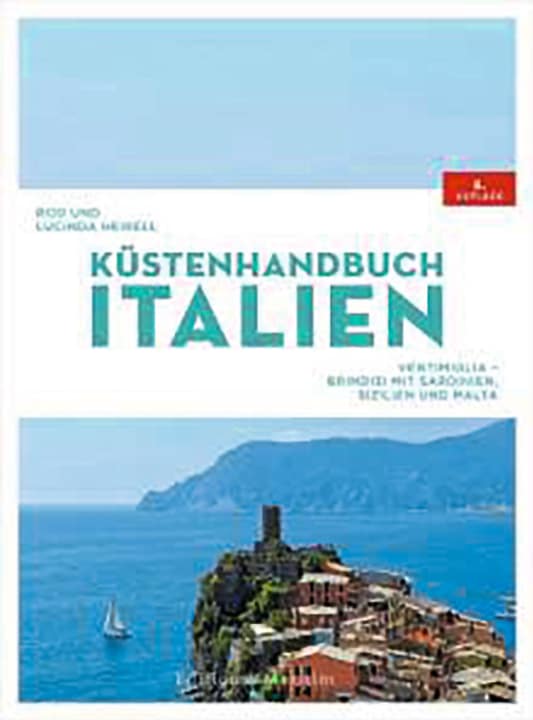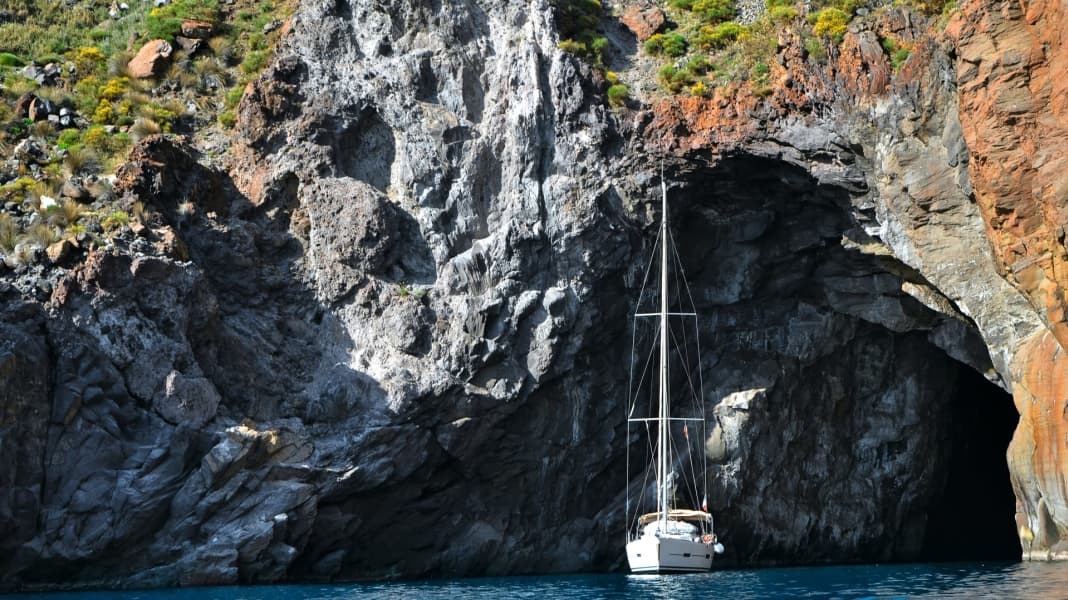
A gentle breeze quietly pushes the boat through the deep, inky blue sea. Sicily to the stern, the archipelago of the seven Aeolian Islands ahead. Yellowish clouds rise like a guiding fire from the crater of Stromboli, Mount Etna above the wake responds with unusually strong smoke signals. There is steam under the boiler.
The volcanic islands erupted from the earth's interior into the sea millions of years ago. Most of the craters are extinct, only sighing quietly and sulphurously here and there. The most famous, Stromboli, can only maintain its composure by constantly releasing pressure - an impressive spectacle. Vulcano is similarly active, only less obvious, quietly mumbling to itself. But it is bubbling underneath. He could explode at any time!
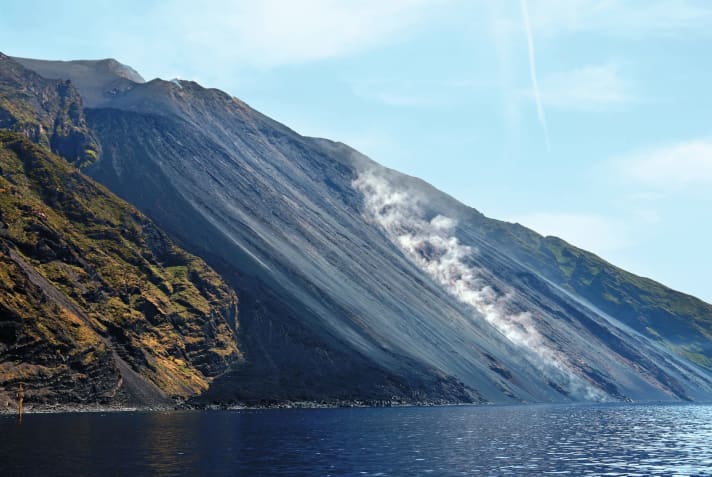
It is only 15 nautical miles from Portorosa on Sicily's north coast to this powder keg. Undecided winds determine the journey. Homer already described the thermal caprices around the islands in his "Odyssey". His errant protagonist is said to have once opened a bag full of wind here; the archipelago is also called the Aeolian Islands after the Greek god of the wind. But Aeolus is moody. A gentle breeze tries sailors' patience until they reach the bay at Punta di Capo Secco Vulcano.
The first anchor manoeuvre takes your breath away: There are only two cable lengths between 50 and five metres of water. As we approach, the echo sounder bounces in time with the pounding heart. The rocks at the edge of the bay feel close at hand as the iron drops to a depth of six metres.
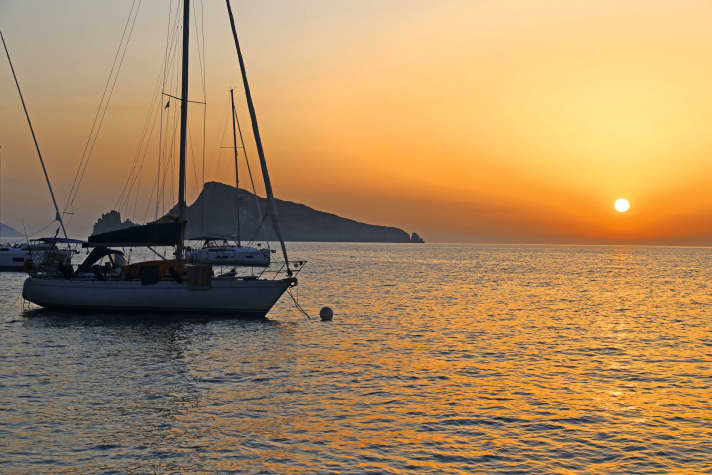
The coastline rises steeply into the sky all around. Few boaters have spent the afternoon here and they all disappear in the evening - tranquillity is the favour of the early season at the end of May. Just around the corner, with the dinghy within rowing distance, stately seagulls circle high above the Grotta del Cavallo. Azure blue, glittering water splashes under a natural arch in the dark rock. In view of this majestic sight, you can't help but whisper in awe. Especially as the sparks of Mount Etna can be marvelled at in the distance as darkness falls.
Just a few nautical miles further north, the island narrows below the volcanic crater. Black sandy beaches line the anchor bays on both sides of the headland. However, instead of the dignified holiday ambience you would expect, a huge hotel complex is lurking on the shore. It protrudes far into the peninsula, the pool area and tennis court overgrown with greenery. A few deckchairs gradually disintegrate in the sun.
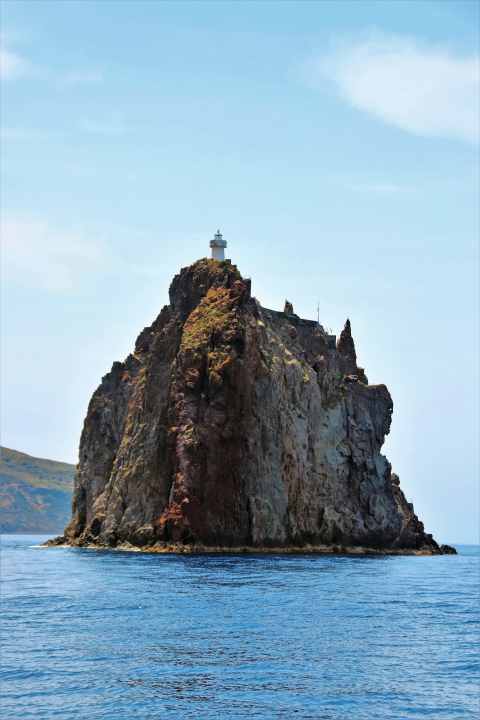
The path past this evidence of former prosperity leads closer and closer to the fumaroles. These are the holes in the earth from which sulphur gases constantly rise - under water as a bubbling spectacle, on land as a yellowish vapour. The idea as to why the hotel is closed penetrates through the nose. The odour is subtle at first, but gets stronger with every step. A stink bomb in the school corridor, rotten eggs in the kitchen - whatever odour association arises, none is positive.
The fumarole whirlpool in the crystal-clear turquoise water is nevertheless surrounded by bathers. Behind it, green-yellow coloured rocks glisten in the sunlight. There is also a sulphur mud bath, which is said to be healing and nourishing for the skin. A smelly test of courage. It is not necessary, the bath is closed. A slightly weathered sign announces an upgrade to a wellness oasis. Before corona, hundreds of tourists came to the island every day. Today it seems to be more in rest and weathering mode. Even the hike up the volcanic crater has to be cancelled due to its inner rumblings. Signs everywhere warn of escaping gases and the risk of poisoning.
For the sake of the nose, the journey continues three nautical miles over to the neighbouring island of Lipari. In the strait, the wind turns around the rocks, picks up speed and then disappears completely in land cover. The entire journey is characterised by constant sail trimming, setting, recovery and the odd hour of motoring.
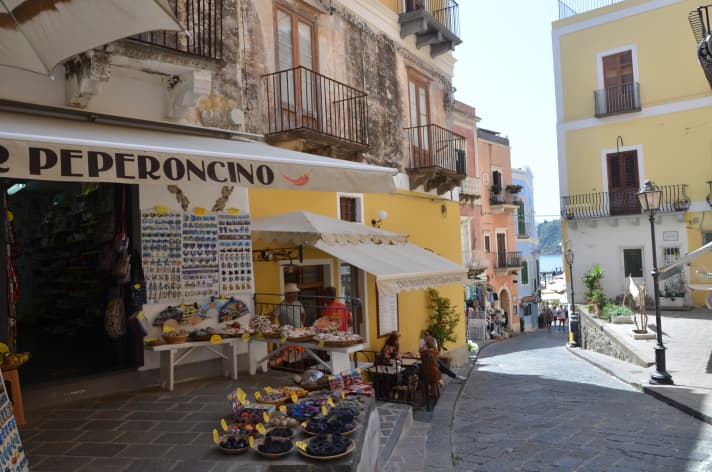
An imposing castle watches over the bay off Lipari. If you don't want to moor in one of the island harbours, you can anchor below it and take a dinghy to the small Marina Corta on the town pier. Fishing boats are moored next to small motorboats from Italian style-conscious design studios. The town is colourful and cheerful and sometimes intimate in alleyways that are barely more than shoulder-width wide, with underwear blowing over your head in the sun or the sound of flushing toilets. Cafés and shops invite you to linger and savour the delicacies. The path leads up through the colourful hustle and bustle to the imposing fortress. Excavations bear witness to the islands' eventful history: Greeks and Romans, a brief Turkish and a longer Arab interlude as well as Norman besiegers determined their fortunes. At times they were lively trading centres, then for decades the most forgotten places in the world. All these phases can be travelled through in fast motion in the different layers of earth around the fort.
It's a little hazy on the way to Panarea. There's something in the air, yellowish and getting cloudier by the day. By far the most expensive island in the archipelago, a meeting place for high society in high summer, has a beautiful anchorage with a sandy bottom directly below the town. Next to it is a marshalling field, which is well frequented even early in the season. Those who prefer a quieter spot will find an anchorage in the north-west of the island at Punta Scritta behind a stately rock.
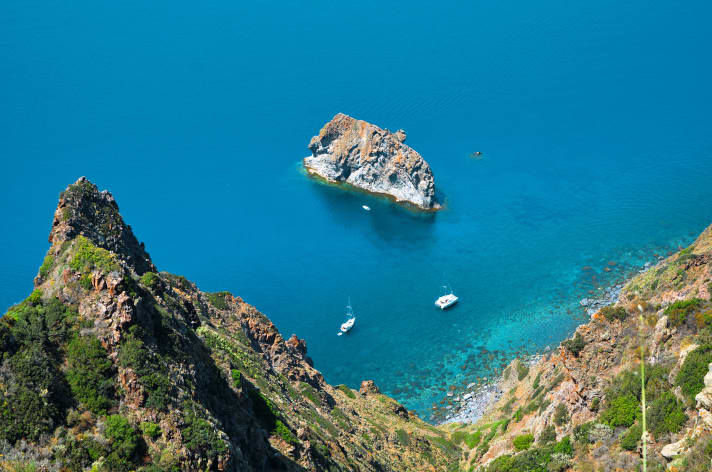
The village of Panarea nestles into the dark rock with white houses and blue doors and shutters. Colourful flowers adorn the gardens and spotlessly clean streets. At lunchtime, the bar "L'Elica" is frequented by men in work waistcoats and rough shoes. The idea that cappuccino and pastries should be affordable here proves to be true. Hidden behind an inconspicuous counter is vanilla ice cream in deep black like the pods from which the delicious spice is extracted, pistachio ice cream without the poisonous green colour and artificial flavourings, strawberry, lime - the choice is difficult.
While leisurely sampling the different varieties on the terrace, you can observe the ingenious traffic routing in the narrow alleyways: Construction materials, food and postal parcels are transported on rattling three-wheelers and small electric lorries. Pedestrians squeeze into the entrances of houses, while oncoming vehicles shift into reverse according to a system that cannot be defined in more detail. Only during the day, mind you, driving is prohibited at night. Panarea takes pride in itself: everything from the shop displays to the menus can be classy, and expensive too, but please don't show off. To this day, the church is the tallest building; luxury blends in with the original architecture.
The travel guide recommends "one of the most attractive hikes in the entire archipelago", more than 400 metres up to the steep coast in the west. The strenuous route leads over gravel and large boulders, often more climbing than hiking - not for the faint-hearted. But every time you take a breather, the magnificent views make the effort worthwhile. Deep below, the water glistens in the bays. Its colour changes from turquoise to emerald to azure blue as the water depth increases. From a height, anchorages look as tiny as sticklebacks, large rocks in the sea like dots on a summer dress. Divers and snorkellers can explore the underwater world of fumaroles and a historic wreck in a circular group of rocks in the east of the island, while the other islands can be seen with the naked eye in the distance.
Stromboli stands out among them in exemplary volcanic form, the real attraction of the trip and the destination of the next stage. But at the anchorage near San Vincenzo in the north-east, fire flickers voraciously close to the town. Fire-fighting aeroplanes and helicopters need the sea space to take on water in flight and extinguish the burning maquis. Ash rains down on the deck.
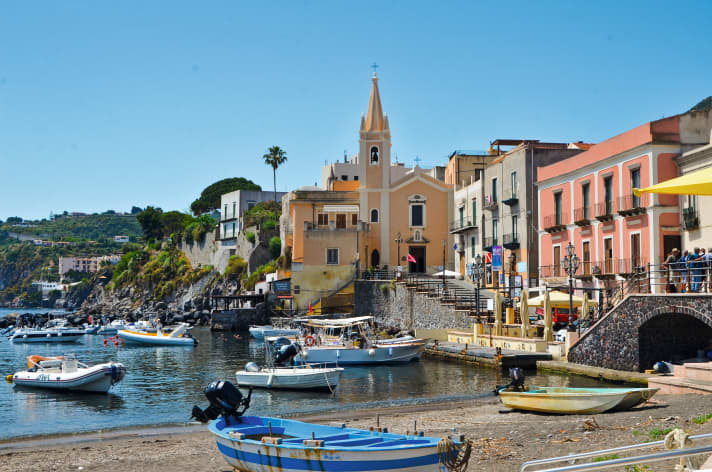
The hike up the volcano has to be cancelled anyway, it is too unsafe in view of the current volcanic irritability. This in turn fires up the famous lava slide in the north-west of the island, where at night the glowing, ejected earth meanders down the slope. "You absolutely have to see it!" was the recommendation of a young Pole on the way, who has succumbed to the islands and sails here again and again. The experience is indescribable and should remain so. During a swim stop on the 1,000 metre depth line below the steaming wall, at a good distance from the flying lava chunks, one of the most violent eruptions of recent decades rises hissing with a huge cloud from the crater. Almost at the same time, the weather app predicts strong winds for the evening. Good reasons to leave the actual destination of the trip far in the wake and set course for the harbour of Santa Marina on Salina.
A veritable party is taking place across several charter boats, while French people stow away considerable quantities of red wine on the catamaran next door. In between them are sailors who have found their way here from New Zealand or England on their own keel and take a distinguished look at the colourful goings-on. "It's still quiet here," explains a marinero with a laugh as he picks up the lines, adding: "From mid-June, there's hardly any free space left in the harbour, and the anchorages get very crowded."
On the greenest of the Aeolian Islands, colourful flowers bloom on every available crumb of earth, with the scent of roses, frangipani and jasmine. The fresh colours continue in the narrow alleyways, on the walls of the houses and in the displays of the small shops selling jewellery, art, clothing and sweet delicacies.
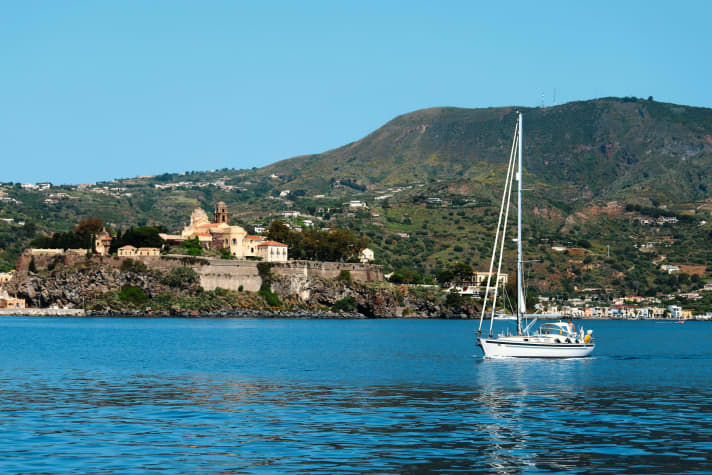
The simple white walls and furnishings in the restaurant "'nni Lausta" look reservedly exclusive in the midst of this colour palette. A small sign on the wall discreetly points to a Guide Michelin award, next to which is the notice: "We don't have free WiFi, talk to each other". The guests at the small tables on either side of the Altstadtgasse do just that with satisfied faces. The chef himself occasionally balances out plates. His hair, glasses and all-black clothing give him the air of an artist, and his dishes fulfil his promise. Chef Fabio Giuffrè and his two sisters have been running the restaurant for more than 30 years. They serve almost exclusively local produce. "Thanks to its volcanic soil, the island is very fertile and offers an unrivalled range of vegetables," he explains. Fishing, on the other hand, is almost non-existent and local meat is rare anyway. Accordingly, he chisels seafood, cheese, vegetables and herbs into true delicacies: scampi carpaccio and pasta with wild fennel pesto, pumpkin blossoms filled with ricotta and Malvasia cakes for dessert, accompanied by a remarkable selection of regional wines.
As soon as the bill is paid, a hot wind sweeps through the streets, blowing skirts and ruffling hairstyles. The sirocco, which has been heralding itself for days with increasing haze in the air, makes the boats in the marina dance. Lines stretch, gangways slide off the jetty. Mooring lines are tightened everywhere and contacts are made with other boats, the party evening pauses. After two hours, the fun is over. Boats covered in yellowish dust bob quietly at the jetty.
The Schirokko is due to return in the next few days. For the last time, the boat moves across the Mediterranean water colour palette in a diffuse mix of winds, the view sweeps over steaming slopes and the expanse of the island world; in the destination port of Portorosa on Sicily, it is better in a storm. It has seen better times. Over several floors of once cheerfully pink-coloured buildings, empty shopping arcades exude the atmosphere of a ghost town, with succulents bravely fighting for survival in front of them.
But it is being polished: Cafés and bars are being revitalised, charter agencies are moving into new offices and wash houses are being renovated. It is definitely worth it, because despite its size, the marina conveys a cosy feeling as it meanders around the bend - and slows down the whims of the Aeolus behind high mountains.
Cruising tips
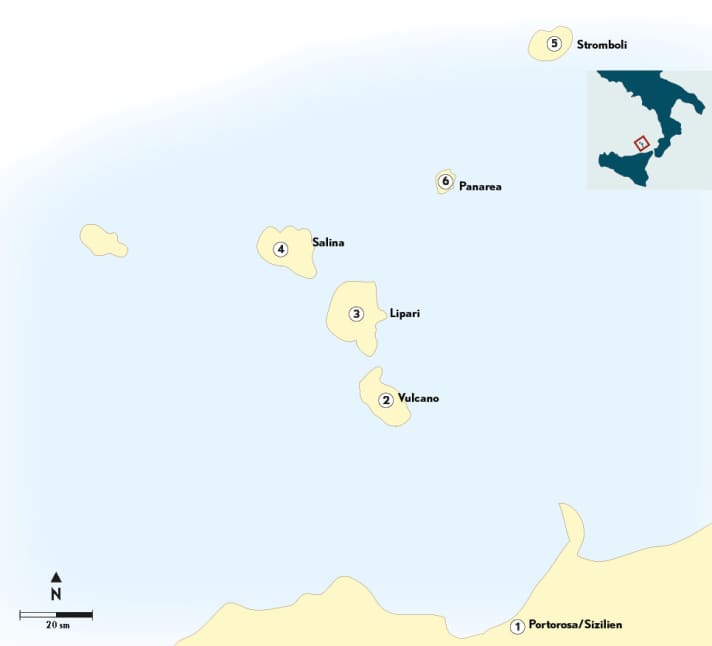
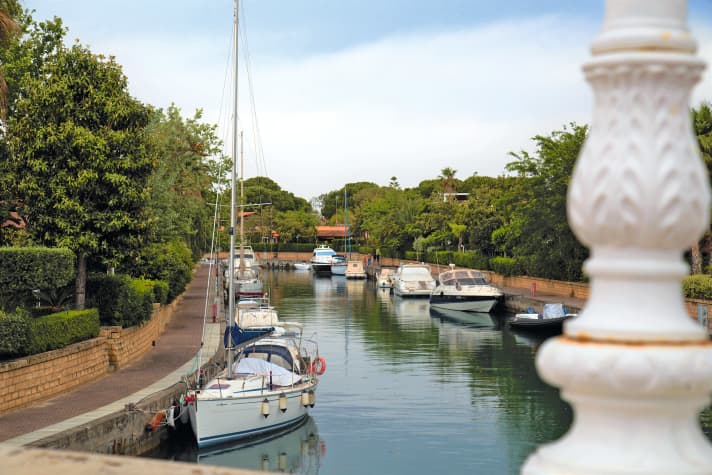
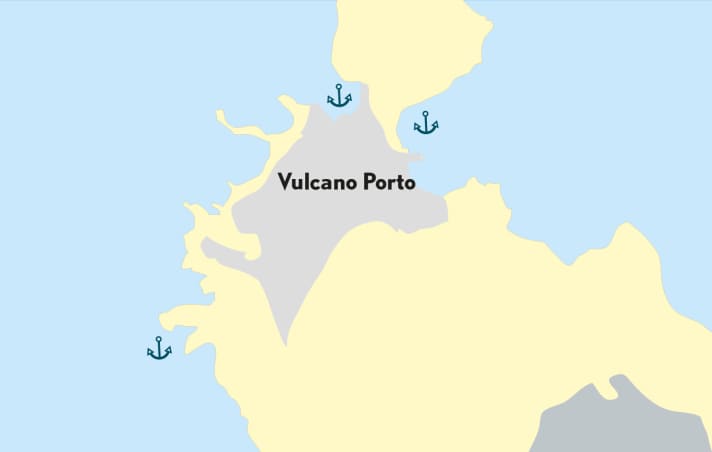

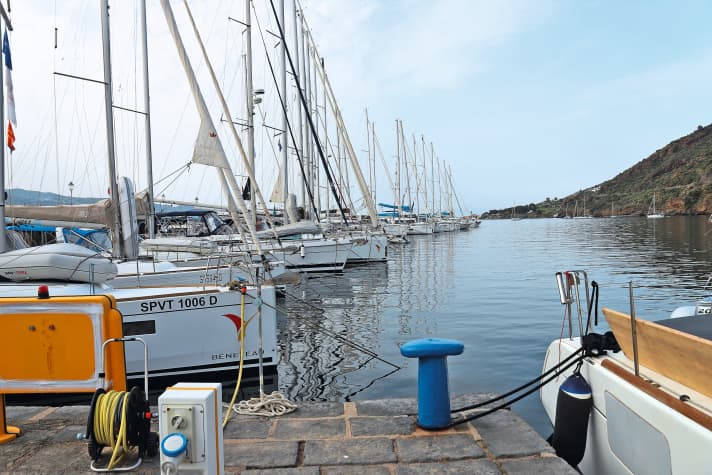
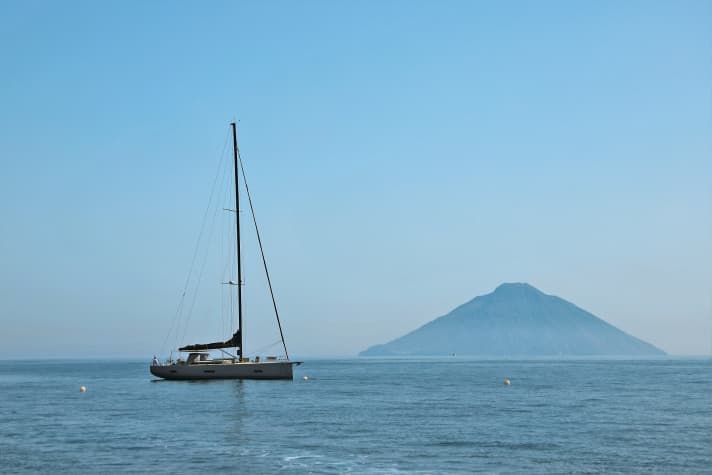
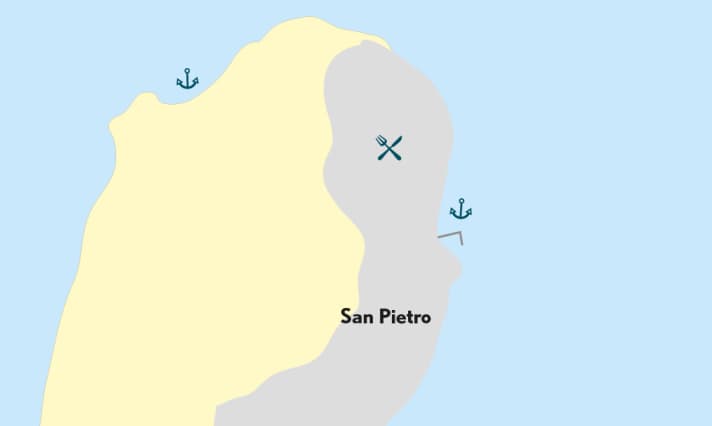
Charter
Ports of departure for the Aeolian Islands are Tropea on the Italian mainland (approx. 30 nautical miles to Stromboli) or Portorosa on Sicily (approx. 15 nautical miles to Vulcano). The yacht from charter company Gais for the trip from Portorosa was organised by Master Yachting (www.master-yachting.de, Tel. 0931/46599999). A Dufour 430 GL from Gais costs from 2,750 euros per week in the low season and 3,750 euros in the high season, plus final cleaning (approx. 180 euros) and bed linen/towels (approx. 20 euros/person).
Volcanoes
The Aeolian Islands are of volcanic origin. Stromboli is one of the most active volcanoes in the world, while Vulcano is considered the most dangerous of the archipelago. Sulphurous vapours are emitted from fumaroles - small channels in the earth's interior. This is a particularly beautiful spectacle underwater, as can be seen on Vulcano or off Panarea.
Navigation
All the islands are within sight, the water is deep and navigation is correspondingly easy. The seabed rises steeply, the anchorages are correspondingly narrow with mostly stony bottoms; a trip line is highly recommended in case the iron gets snagged. Swell must be expected in bays and harbours. In stormy weather, the islands offer hardly any protection; there are harbours only on Salina and Lipari. Sailors should then head for the mainland or Sicily.
Wind & Weather
In the Tyrrhenian Sea, a rather weak Tramontana blows from the north-west in summer. Cape and jet effects and sudden lulls near the high, steep islands. Occasionally, the sirocco coming from the south interrupts the calm with strong wind phases, powerful gusts and Sahara dust. It announces itself with a falling barometer and hazy air. Between May and October, the thermometer climbs to over 20 degrees, in July and August to over 30 degrees. The water is wonderfully warm and it rarely rains.
Literature
